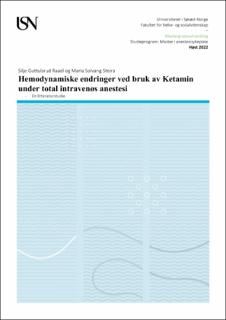| dc.contributor.advisor | Flo, Jill Britt-Marie | |
| dc.contributor.author | Raael, Silje Guttulsrud | |
| dc.contributor.author | Steira, Maria Solvang | |
| dc.date.accessioned | 2023-12-07T17:41:32Z | |
| dc.date.available | 2023-12-07T17:41:32Z | |
| dc.date.issued | 2022 | |
| dc.identifier | no.usn:wiseflow:6701905:52835801 | |
| dc.identifier.uri | https://hdl.handle.net/11250/3106498 | |
| dc.description.abstract | Introduksjon: I forbindelse med generell anestesi får pasienter anestesimidler som påvirker sirkulasjonen negativt. Ketamin har en kardioprotektiv effekt som gir økt blodtrykk og hjertefrekvens. Ved å tilføre Ketamin i forbindelse med anestesi og kirurgi vil man i teorien kunne unngå alvorlig hypotensjon og dermed få en mer hemodynamisk stabil pasient. Anestesisykepleiere har en nøkkelrolle i forhold til pasientsikkerhet og hvis Ketamin bedrer perioperativ hemodynamikk burde man kunne bruke det til relativt friske elektive pasienter.
Hensikt: Hensikten med studien var å undersøke om det å gi Ketamin i forbindelse med total intravenøs anestesi kunne bidra til en mer hemodynamisk stabil pasient. I tillegg vurdere hvilke fordeler og ulemper som kunne oppstå i forbindelse med bruken av Ketamin.
Metode: En systematisk litteraturstudie ble gjennomført ved systematiske databasesøk i relevante databaser, samt usystematiske søk i referanselister. Etter gjennomgang av databasetreff opp mot inklusjons- og eksklusjonskriteriene ble det funnet 8 artikler som ble inkludert i studien.
Resultater: Resultatene ble fremstilt gjennom tematisk analyse og presenteres i fem temaer; Hemodynamiske endringer, Oppvåknings- og restitusjonstid, medikamentforbruk, postoperative komplikasjoner og smerter. Resultatene vist at pasientene som fikk Ketamin hadde mer stabil hemodynamikk i forbindelse med innledning av anestesi og det perioperative forløpet. De hadde mindre Propofol-relaterte injeksjonssmerter, mindre smerter postoperativt og lavere medikamentforbruk. Ketamin ga forlenget oppvåkningstid, og pasientene lå lenger på postoperativ avdeling. Forekomsten av postoperativ kvalme og oppkast var uendret sammenlignet med de som kun fikk Fentanyl.
Konklusjon: Bruk av Ketamin i forbindelse med total intravenøs anestesi kan gi hemodynamisk stabilitet i forbindelse med innledning og det perioperative forløpet. Fordeler med Ketamin er at det lindrer både Propofol-induserte- og postoperative smerter. Ketamin-relaterte bivirkninger kan forebygges. Ulemper med Ketamin er forlenget oppvåkningstid og postoperativ liggetid | |
| dc.description.abstract | Introduction: In general anaesthesia patients are given anesthetics that have a negative effect on circulation. Ketamine has a cardioprotective effect that increases blood pressure and heart rate. Administring Ketamin during anaesthisia and surgery would theoretically avoid severe hypotension and result in a more haemodynamically stable patient. Nurse Anesthetists have a key role in patient safety, and if Ketamine improves perioperative haemodynamics it should be possible to also use it in relatively healthy elective patients.
Purpose: The purpose of the study was to investigate whether adding Ketamine to total intravenous anesthesia could contribute to a more hemodynamically stable patient. We also wanted to investigate which advantages and disadvantages that could occur with the use of Ketamine.
Method: A systematic literature review was conducted by systematic database searches in relevant databases, as well as unsystematic searches in reference lists. After reviewing database results against the inclusion and exclusion criteria, 8 articles were found and included in this study.
Results: Results were presented through thematic analysis and consist of five main themes.; Haemodynamic changes, Emergence- and recovery time, drug consumption, post-operative complications and pain. The results showed that the patients receiving Ketamine had more stable hemodynamics during the induction of anesthesia and the perioperative period. They had less Propofol-injection pain, less pain postoperatively and lower drug consumption. Ketamine prolonged the recovery time and the patients stayed longer in the postoperative ward. The incidence of postoperative nausea and vomiting was unchanged compared to those receiving Fentanyl alone.
Conclusion: The use of Ketamine in connection with total intravenous anesthesia can provide hemodynamic stability during induction and the perioperative period. Advantages of Ketamine are that it relieves both Propofol-induced and postoperative pain. Ketamine-related side effects can be prevented. Disadvantages of Ketamine are prolonged emrgence- and recovery time and postoperative length of stay. | |
| dc.language | nob | |
| dc.publisher | University of South-Eastern Norway | |
| dc.title | Hemodynamiske endringer ved bruk av Ketamin under total intravenøs anestesi | |
| dc.type | Master thesis | |
